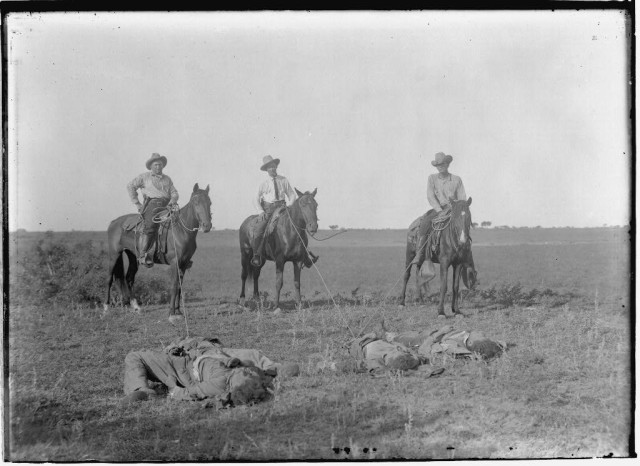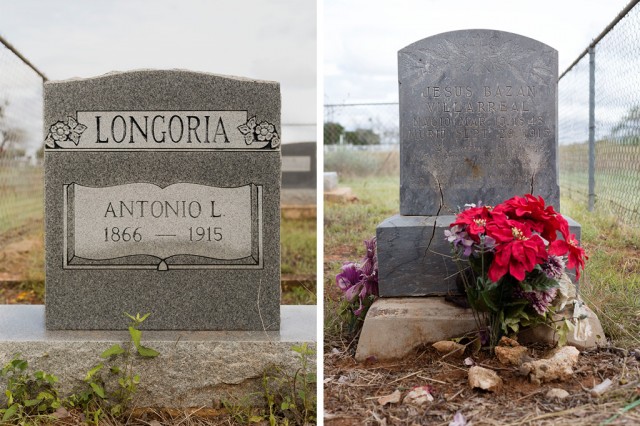Scholars Work to Tell a Dark Chapter in Texas History
By Lucia Benavides
Reporting Texas and the Austin American-Statesman

This archival photo from the early 1900s shows Texas Rangers with the lassoed bodies of men they had shot. The original caption said “dead bandits.” But scholars say the Rangers killed some people without cause, or purely on suspicion that they might be thieves or troublemakers. Photo courtesy of the Briscoe Center for American History at the University of Texas at Austin
By Lucia Benavides
For Reporting Texas and the Austin American-Statesman
On a late September day in 1915, Texas Rangers shot and killed Jesus Bazan and his son-in-law, Antonio Longoria, as they rode their horses along a dirt road not far from their ranch near Edinburg.
The men had committed no crimes, but the Rangers suspected they sympathized with Mexican bandits who had been raiding local ranches. Without warning, the Rangers shot the men and left the bodies where they fell. Two days later, neighbors found the corpses and buried them.
The story survives because a witness, Roland Warnock, recorded an oral history of the killings. His grandson, Kirby Warnock, made a 2004 documentary, “Border Bandits,” about this violent but largely untold chapter in South Texas history.
Now, six scholars, including four from Texas, have built a website, RefusingtoForget.com, to make sure this part of Texas history is fully told and accessible to the public.
From 1915 to 1919, the scholars say, the Rangers or vigilantes killed hundreds, possibly thousands, of Mexicans and Tejanos. Some of the victims were bandits or Mexican revolutionaries trying to stir up trouble in South Texas. But many were like Bazan and Longoria — people caught in the crossfire.
“This part of history matters because the state has never taken responsibility,” said Monica Martinez, an assistant professor of American and ethnic studies at Brown University, who is part of the group. “People continue to be impacted by these histories, every time a mother shares her family’s story with her young child. People understand the present by the collective wisdom of past generations.”
The scholars’ efforts are paying off. Thanks to their lobbying, the Bob Bullock Texas History Museum will open an exhibit in January about the era, including the killings.

Rangers shot Jesus Bazan and Antonio Longoria as they rode their horses
near their South Texas ranch. Neighbors found their bodies, buried them and later
erected gravestones. Photos by Miguel Gutierrez Jr./Reporting Texas
“We cover all of the stories of Texas, and this is one of them,” said Margaret Koch, director of exhibits at the museum. “It’s important to tell this story.”
In addition, the scholars persuaded the Texas Historical Commission to erect markers commemorating the bloody conflict pitting Texans against Tejanos. One will be in Laredo, to mark the Primer Congreso Mexicanista in 1911, the state’s first Mexican-American civil rights conference. It was prompted by the 1910 lynching of Antonio Rodriguez, who had been arrested on charges that he killed an Anglo woman in Rocksprings. A vigilante mob seized him, tied him to a tree and burned him alive. A second Laredo marker will honor Jovita Idar, a journalist and civil-rights activist who crusaded against such killings.
The third marker, near Los Indios in Cameron County, will commemorate the period known as La Matanza, or The Massacre. The term describes the surge of anti-Mexican mob violence in South Texas a century ago. Historians dispute the numbers but estimate 300 to 5,000 Mexican-Americans were killed in that period.
John Morán González, associate professor of English at the University of Texas at Austin and a member of the scholar group, said the wide range of estimated deaths is due to the “extralegal nature of the violence and the reprehensible attempts by those perpetrators to leave no official, incriminating record.”
A timeline on the website of the Official Texas Rangers Hall of Fame and History Museum in Waco says 300 Mexicans and Tejanos “may have been killed” by Rangers, vigilantes or local citizens, while Mexican raiders killed 21 people. The timeline acknowledges that some think the number is higher.
Stories of individual killings have been passed down through Hispanic families, including the Longorias, whose current generation includes TV and movie actress Eva Longoria. But the Refusing to Forget group asserts that Texas public schools do not teach students about the violence of the period.

Professor John Moran Gonzalez at UT is part of a scholar group working to make sure a violent period in South Texas is fully told. Photo by Martin do Nascimento/Reporting Texas
Public school students take Texas history in fourth and seventh grades. The Texas Education Agency sets curriculum standards for those courses, although teachers can expand on them. Standards for seventh-grade Texas history do not include content about La Matanza.
While the indiscriminate killing of Mexicans had been going on since the mid-19th Century across the Southwest, the violence increased around 1915, as the Mexican Revolution roared across the border, Martinez said. Mexicans influenced by the uprising and angered by the large influx of Anglos who had moved to South Texas in search of cheap land called for Tejanos to reclaim what was once theirs.
The “bandits” stole horses and food from Anglo ranchers and killed some of them.
“It’s not like there was no reason for Anglos in South Texas to fear violence,” said Benjamin Johnson, assistant professor of environmental history at Loyola University Chicago and a group member. “This is not a product of the imagination.”
Johnson documented the events in his 2003 book, “Revolution in Texas: How a Forgotten Rebellion and Its Bloody Suppression Turned Mexicans into Americans.”
Around 1915, the Rangers were sent to rid South Texas of perceived troublemakers and suppress Mexican revolutionaries. But the Rangers and other authorities didn’t just kill bandits — they killed anyone they deemed suspicious, Johnson said.
Scholars say it wasn’t always clear that the victims were in fact bandits. One victim was a Mexican teenager killed minutes after getting off a train in Mercedes, according to Johnson’s book. A hand tumor had forced the teenager to wear a sling on one arm. The Rangers, looking for a man shot in the hand in a recent raid, arrested the teenager on suspicion. He was found dead several minutes later, Johnson said.
The situation became so fraught that, in 1919, the Texas Legislature conducted an investigation into the killings, took testimony from local residents and ordered the Ranger ranks be reduced in size.
“There were so many innocent people killed in that mess that it just made you sick to your heart to see it happening,” Roland Warnock said in a recording his grandson made in 1974 for Baylor University’s oral history project. “If those ranchers caught a Mexican with a bunch of cattle, they didn’t ask him where he got them, they killed him … A man’s life just wasn’t worth much at all.”
Although many Texans aren’t familiar with this part of history, for some it’s a lived reality. “It still has that palpable presence, so we want to have their stories told as a living legacy,” Morán González said. “Keeping silent perpetuates the injustices done.”